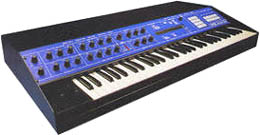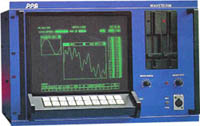|
Nostalgia demo 1
Nostalgia demo 2


|
 |
It's probably fair to say
that the name PPG (Palm Products Germany) is probably synonymous
with digital synthesisers and other innovations in this field. However,
Wolfgang Palm, the company's founder, was actually making mammoth
modular analogue synthesiser systems as far back as 1975 to rival
(and even exceed) Moog's huge modular sytems.
Palm's products caught the attention of German synth
music pioneers, Tangerine Dream, who used many of Palm's innovative
modules and became quite involved with Palm. It was no doubt TD's
commissions that were instrumental in supporting PPG at the time. |
With this support and backing, PPG continued
to grow with the release of further analogue products.
However, Palm could see that the future was in digital
technology and started work in this direction in 1977 which resulted
in the release of little known (and unsuccessful) products such
as the Wavecomputer and others.
It was the PPG Wave synth, however, that caught musicians'
attention.
Digital synthesis was in its infancy at the time. Most
of what was available required a CRT and other alien operating methods
which were intimidating for people raised on oscillators and filters
and envelope generators, etc.. But with the PPG Wave, here was a
polyphonic synth that to all intents and purposes looked and 'felt'
like an analogue synth but which was essentially digital. In fact,
the Wave was a digital/analogue hybrid - it had digital oscillators
and other digital circuitry but it also had true analogue filters
using the fabled Curtis filter chips found in the equally fabled
Prophet synths. This combination was a winner.
First came the Wave 2 in 1981. The Wave 2 was an 8-voice
polysynth with a single oscillator per voice. It enjoyed marginal
success but sounded a bit 'sterile' in comparison with analogue
synths' detuned oscillators. It was the Wave 2.2 released a year
later with two oscillators per voice that really elevated PPG's
standing in the market.
At the heart of the PPG Wave synths were their digital
wavetable oscillators. Whereas we'd been used to four or five waveforms
per oscillator with analogue synths, the PPG Wave offered 64 waveforms
in 30 'wavetables'. You would select a wavetable and then select
one of the 64 waveforms it contained. In total, that's 1,920 waveforms
per oscillator to play with!
But what was unique to the PPG Wave was its ability to
modulate waveform selection within any one wavetable with a wide
range of controllers.Thus you could sweep through the waveforms
in any of the wavetables using envelopes, LFOs, pitch bend, modwheel,
keyboard position and more. For technical reasons, these new digital
synths weren't able to provide facilities we took for granted on
analogue synths such as sync sweep and PWM so some of the wavetables
were given over to re-creating these sounds. A fine idea in principle
except.....
Waveform modulation wasn't smooth and as you swept through
a wavetable's waveforms, you could hear each waveform changing abruptly
from one to the other in audible steps. As a result, certain sounds
(such as sync sweep and PWM) weren't convincing. Many saw this as
a limitation - others (such as Tom Dolby) exploited this 'characteristic'
to create totally unique sounds.
The final few waveforms of every wavetable were always
sawtooth, square and pulse waves and so the PPG could do fairly
decent analogue sounds as well. |
But despite looking and 'feeling' like an analogue
synth, the implementation of this user interface was somewhat quirky
for the time.
Yes - it had a good complement of knobs to adjust the
most important synth parameters but a lot of the parameters were
accessed and adjusted using the numeric keypad and 'mode' keys to
the right of the LCD. It was here as well that you accessed the
PPG's eight-track multi-timbral sequencer.
These were all new concepts at the time that took some
getting used to. |
 |
At the end of the day, though, it wasn't so much the
innovative new ideas and concepts that people were paying for -
it was the 'sound' of the PPG that people wanted.
The PPG sounded glorious and fresh and new - bright and
tingly and with jagged sounds that could cut through a mix like
a hot knife through butter. It was also equally capable of smooth,
glassy, ethereal pads and much more besides and with this new, exciting
pallette of sounds on offer, many musicians embraced the PPG with
open arms. In fact, the list of users reads like a "who's who"
of the leading artists of the time - David Bowie, The Fixx, Trevor
Horn, Jean Michel Jarre, Art of Noise, Rush, Depeche Mode, Gary
Numan, Robert Palmer, Psychadelic Furs, Talk Talk, The Cars, Ultravox,
Steve Winwood, Rush, Stevie Nicks, Tangerine Dream, Thomas Dolby,
Pet Shop Boys, Mike and the Mechanics and Stevie Wonder to name
just some. Canadian band Saga, loved the instrument so much that
they set up the Canadian distributorship for the product! Lesser
known users include the band Freur and, of course, Hollow Sun -
we once owned a Wave 2.2 and we loved it! |
| 
|
The first PPG Wave synths were strictly
8-bit and the coarseness of some (if not many) of the waveforms
had a certain lo-fi charm that added a lot of 'edge' to the sound.
In particular, the lack of any serious anti-aliasing meant that
bass sounds were particularly brittle and cutting. PPG upgraded
the range and the Wave 2.3 was 12-bit.
PPG also released their Waveterm (left), a separate CRT/CPU
unit that gave the PPG Wave 2.3 sampling, waveform analysis, floppy
disk storage and many other features to rival the Fairlight. |
So.... things were looking good for PPG. Their Wave
synth was unique in the market and there seemed to be no competition.
Until 1983 that is....
Like most other synth manufacturers of the time, PPG
had the wind knocked out of their sales with the release of the
Yamaha DX7! Ironically, being digital itself, the DX7 was quite
capable of emulating many of the sounds that had characterised the
PPG Wave synths. It also had MIDI, had twice the polyphony and was
considerably cheaper. Sadly, it looked as though the writing was
now on the wall for this innovative German synth manufacturer.
Despite attempts at adding MIDI, etc., the PPG Wave synths
gradually disappeared into obscurity retaining only a few devotees
and an iconic status in the annals of music history. The company
struggled on until 1987 when it eventually collapsed.
Many years later, however, Wolfgang Palm revived the
concept successfully with Waldorf in the shape of the ingeniously
named 'Microwave', a modern day take on the concept in a 2U rack
mount unit. Waldorf went on to produce many other successful products
whose roots lie in the innovations pioneered in the original PPG
Wave synths. |
|

